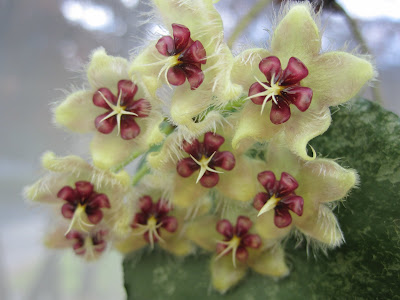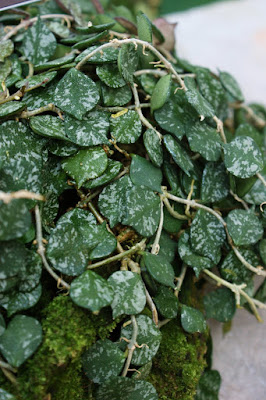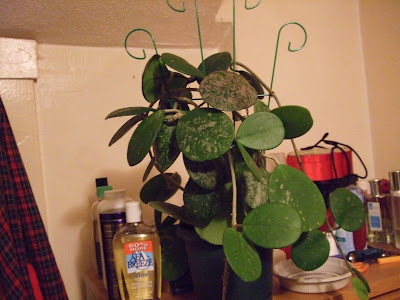Hoya caudata is found growing epiphytically on trees in lowland forests and limestone hills, where it is known to be common, but not in abundance...
Hoya caudata, also called as Hoya caudata 'Sumatra', Hoya crassifolia, Hoya flagellata, is a species of the genus Hoya. This species was described by Joseph Dalton Hooker in 1883. The species epithet refers to the 'tail like' (caudate) appendages of the anther.
IDENTIFY HOYA CAUDATA
Hoya caudata is native to Borneo, Malaya, Sumatera, Thailand. It is
found growing epiphytically on trees in lowland forests and limestone hills,
where it is known to be common, but not in abundance.
It is a vining epiphytic plant with thin wiry, about 0.3 cm thick stems. Adventitious roots are freely produced along the stem to help anchor the plant securely to the substrate. The leaves are ovate, 4-15 cm long by 2.5-7 cm wide; mature leaves thick leathery and stiff, rough to the touch. Upper leaf surface characteristically mottled, base color dull-mid green or olive green, often tinged with brown, and with dull grey - very dull pale green blotches. Young leaves dull reddish brown with dull grey markings. Plants exposed to very bright light or full sun may have leaves that are completely red in color.
The plant blooms in spring to late summer from the spurs that appear from the axils of the leaves and stem. The flowers are peachy-white with purple centers. They are star-shaped, and are borne in clusters that look like they are made of wax. The flower's surface is covered in tiny hairs giving a fuzzy appearance. They are heavily scented. The scent is strongest in the early evening.
HOYA CAUDATA CARE AND CULTURE
Cultural information should only be used as a guide, and should be to be adapted to suit you. Your physical location; where you grow your plants, how much time you have to devote to their care, and many other factors, will need to be taken into account. Only then can you decide on the cultural methods that best suit you and your plants.
Light:
Hoya caudata grow best in medium to bright indirect light with light level of 10000-20000 lux. While it is tolerant of lower light conditions, you may notice leggy growth as a result. It can withstand 3 hours of direct sunlight but the plant should avoid to get too much direct sun because the leaves will burn. Dappled sunlight is ideal.
Temperature:
The plant can grow in USDA zone 11-13. It prefers average to warm temperatures of 18-29 °C. Do not expose the plant to temperatures below 15 °C even for a short time because cold air will damage the foliage. Avoid cold drafts and sudden temperature changes.
Humididty:
Hoya caudata grow best with the humidity level of 50% - 60%. It will thrive in almost any environment, but if you want to give it a special treat, gently mist it once a week. It's best to mist your plant in the morning so the water has plenty of time to evaporate before evening.
Substrate and growing media:
The plant need a well-aerated, quick-draining potting soil that dries out quickly. It thrive in moist soils with high organic matter and grow best when provided with a mossy post or burlap wrapped pole to climb. If given a trellis, it will climb and its leaves will become bigger and more fenestrated.
You can use a blend of large-chunk orchid bark, coarse-grade perlite, and peatmoss at equal ratios; and then add about 10% charcoal which helps remove toxicities that can build up (over many months) in the potting mix.
Watering:
Water the plant once weekly. Allow the potting mix to dry out before watering. Water more frequently during warmer months and growth season. Do not overwater or keep the soil wet for too long, as this will encourage root rot. If the leaves are yellowing due to overwatering, skip a week or two of watering.
Fertilizer:
Feed the plant between every two weeks or once per month during their growing season with a balanced houseplant fertilizer diluted to half strength. In the late fall and winter, when growth has slowed down, and the plant is dormant, do not fertilize your plant. Too much fertilizer can burn the foliage of your plant. Before applying fertilizer in any form, make sure the soil is damp.
Pruning:
Prune lightly in the spring season or after the flowering cycle is complete, when you feel it’s growing heavily. Pruning is necessary for this plant to maintain a bushy but neat appearance. You should also trim the foliage if the plant has diseases or fungal infections to get rid of the damaged parts from the plant. Avoid removing the peduncles while pruning because that’s where the flowers will appear in the next blooming season.
Pests and diseases:
Hoya caudata are affected by four main garden pests: aphids, mealy bugs, spider mites and scale insects. These are easily controlled by systemic insecticides, unless you are opposed to their use. Many control them with rubbing alcohol sprayed onto the plant in a diluted form (water) added to this is soap to make it "stick". Spray this mix onto the plant in the cool of the afternoon when the sun has lost its bite. When using chemical sprays follow the instructions on the label explicitly even so-called harmless sprays have powerful effects on the human body.
Propagation:
Hoya caudata is easy to propagate by take cuttings that have two nodes. A node is a place where the leaves emerge from the stem. Make sure you use sterilized cutters or shears. Make the cut without damaging any healthy leaves on the plant. Dip the end of cutting in the rooting hormone, although this is optional. Rooting hormones have anti-fungal properties and help the cut callus quickly. Either place them in a vase with water or into a jar with moist sphagnum moss. Check on them every few weeks. Once the roots establish, transfer it to a good potting mixture.















Thank you for such an informative and well written article. It is very helpful.
ReplyDelete